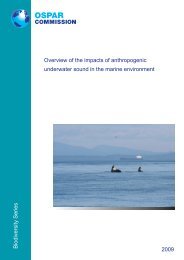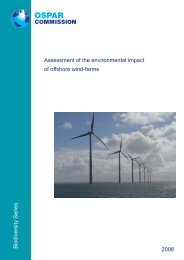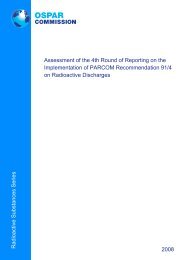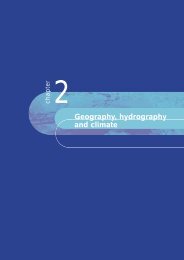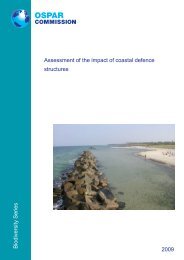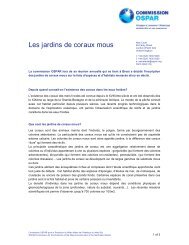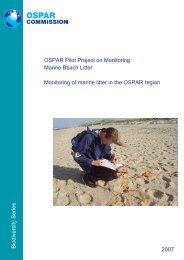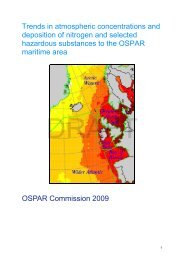Assessment of Modiolus modiolus beds in the OSPAR area Ivor ...
Assessment of Modiolus modiolus beds in the OSPAR area Ivor ...
Assessment of Modiolus modiolus beds in the OSPAR area Ivor ...
Create successful ePaper yourself
Turn your PDF publications into a flip-book with our unique Google optimized e-Paper software.
Ecological significance<br />
The species composition <strong>of</strong> <strong>Modiolus</strong> <strong>beds</strong> is variable and is <strong>in</strong>fluenced by <strong>the</strong> depth, degree <strong>of</strong> water<br />
movement, substratum and densities. Three ma<strong>in</strong> components are:<br />
• Very dense aggregations <strong>of</strong> liv<strong>in</strong>g and dead <strong>Modiolus</strong> shells which form <strong>the</strong> frame work <strong>in</strong> a<br />
s<strong>in</strong>gle or multiple layers<br />
• A rich community <strong>of</strong> free liv<strong>in</strong>g and sessile epifauna and predators.<br />
• A very rich and diverse community which seeks shelter <strong>in</strong> <strong>the</strong> crevices between <strong>the</strong> <strong>Modiolus</strong><br />
shells and byssus threads and flourishes on its rich sediment.<br />
Brown & Seed (1977) recorded 90 <strong>in</strong>vertebrate taxa associated with <strong>Modiolus</strong> clumps <strong>in</strong> Strangford Lough,<br />
with most <strong>of</strong> <strong>the</strong> major groups well represented. Holt and Shalla (unpublished) found 270 <strong>in</strong>vertebrate taxa<br />
associated with <strong>Modiolus</strong> reef <strong>area</strong>s to <strong>the</strong> north-east <strong>of</strong> <strong>the</strong> Isle <strong>of</strong> Man, and suggested that this was likely to<br />
be an underestimate, particularly <strong>in</strong> terms <strong>of</strong> sponges and <strong>in</strong>fauna. Because <strong>of</strong> <strong>the</strong> abundant epifauna and<br />
<strong>in</strong>fauna <strong>Modiolus</strong> <strong>beds</strong> haves been considered to support one <strong>of</strong> <strong>the</strong> most diverse sublittoral communities <strong>in</strong><br />
north-west Europe (Holt et al., 1998).<br />
The possible role <strong>of</strong> <strong>Modiolus</strong> reef communities <strong>in</strong> provid<strong>in</strong>g a nursery refuge for o<strong>the</strong>r species is<br />
occasionally mentioned <strong>in</strong> <strong>the</strong> literature but does not appear to have been <strong>in</strong>vestigated. Dense growths <strong>of</strong><br />
bushy hydroids and bryozoans could conceivably provide an important settl<strong>in</strong>g <strong>area</strong> for spat <strong>of</strong> bivalves such<br />
as <strong>the</strong> scallops Pecten maximus and Aequipecten opercularis, adults <strong>of</strong> which are <strong>of</strong>ten abundant <strong>in</strong> nearby<br />
<strong>area</strong>s.<br />
The byssus threats <strong>of</strong> <strong>the</strong> M. <strong>modiolus</strong> have an important stabilis<strong>in</strong>g effect on <strong>the</strong> seabed, b<strong>in</strong>d<strong>in</strong>g<br />
toge<strong>the</strong>r liv<strong>in</strong>g M. <strong>modiolus</strong>, dead shell and sediments. As M. <strong>modiolus</strong> is a filter feeder <strong>the</strong><br />
accumulation <strong>of</strong> faeces and pseud<strong>of</strong>aeces probably represents an important flux <strong>of</strong> organic material<br />
from <strong>the</strong> plankton to <strong>the</strong> benthos.<br />
Relevant additional considerations<br />
Changes <strong>in</strong> relation to natural variability<br />
Many aspects <strong>of</strong> <strong>the</strong> reproduction, development and growth <strong>of</strong> <strong>Modiolus</strong> seem to be highly variable. Natural<br />
fluctuations <strong>in</strong> spawn<strong>in</strong>g, settlement and recruitment <strong>in</strong>to adult sizes occur <strong>in</strong> some <strong>beds</strong>, with predation <strong>of</strong><br />
young mussels probably be<strong>in</strong>g very <strong>in</strong>fluential. These must affect <strong>the</strong> population structure over periods <strong>of</strong> a<br />
few years, but <strong>in</strong> <strong>the</strong> long term <strong>the</strong>y seem to be stable features.<br />
<strong>OSPAR</strong> Commission<br />
DRAFT<br />
Dense reefs and <strong>beds</strong> are thought <strong>in</strong> general to be very stable <strong>in</strong> <strong>the</strong> long term, despite somewhat <strong>in</strong>termittent<br />
recruitment <strong>in</strong> some cases. This is based upon observations that reefs are consistently found <strong>in</strong> <strong>the</strong> same<br />
place over long time periods, but to what degree <strong>the</strong> <strong>Modiolus</strong> population structure, physical nature <strong>of</strong> <strong>the</strong><br />
reefs, or <strong>the</strong> associated community structure might vary does not appear to have been studied. The variable<br />
nature <strong>of</strong> recruitment <strong>in</strong> at least some populations demonstrates that some variation <strong>in</strong> <strong>Modiolus</strong> population<br />
structure with time must occur, but this has not been described <strong>in</strong> any detail (Holt et al., 1998).<br />
Predation <strong>of</strong> young <strong>Modiolus</strong> by crabs and starfish, <strong>in</strong> particular, appears to be important. Factors affect<strong>in</strong>g<br />
<strong>the</strong> proportion <strong>of</strong> young <strong>Modiolus</strong> surviv<strong>in</strong>g through to <strong>the</strong> size at which predation appears no longer to be a<br />
serious threat have not been studied, although <strong>in</strong> comparison with Mytilus reefs, which are composed <strong>of</strong><br />
much younger animals, <strong>the</strong> effect <strong>of</strong> one or two ‘bad years’ <strong>of</strong> recruitment would be far less serious. It is<br />
suspected that juveniles liv<strong>in</strong>g with<strong>in</strong> <strong>the</strong> mass <strong>of</strong> adult byssus threads have greatly enhanced chances <strong>of</strong><br />
survival, <strong>in</strong> which case <strong>in</strong>faunal <strong>Modiolus</strong> could be at a disadvantage s<strong>in</strong>ce <strong>the</strong> byssus may be largely<br />
<strong>in</strong>accessible.<br />
Expert judgement<br />
More <strong>in</strong>formation is needed on <strong>the</strong> extent and status <strong>of</strong> this habitat. However, under <strong>the</strong> concept <strong>of</strong><br />
precaution, <strong>the</strong> <strong>in</strong>clusion <strong>of</strong> this habitat is considered as sensible, until more research on its status is<br />
completed given <strong>the</strong> observed impacts and decl<strong>in</strong>e <strong>in</strong> well-studied locations, and <strong>the</strong> demonstrated threat to<br />
this habitat from certa<strong>in</strong> fish<strong>in</strong>g methods that are widespread <strong>in</strong> <strong>the</strong> <strong>OSPAR</strong> Maritime Area.<br />
19 <strong>of</strong> 22



